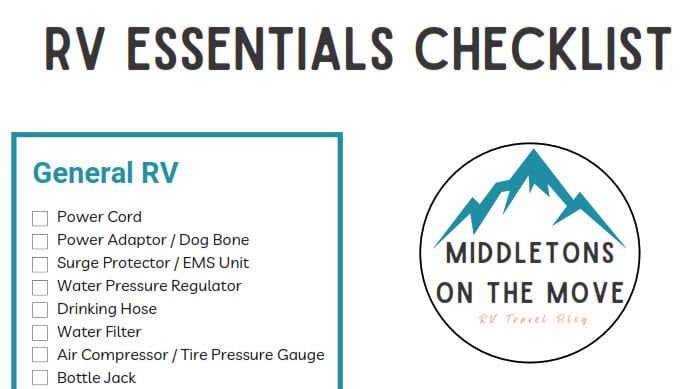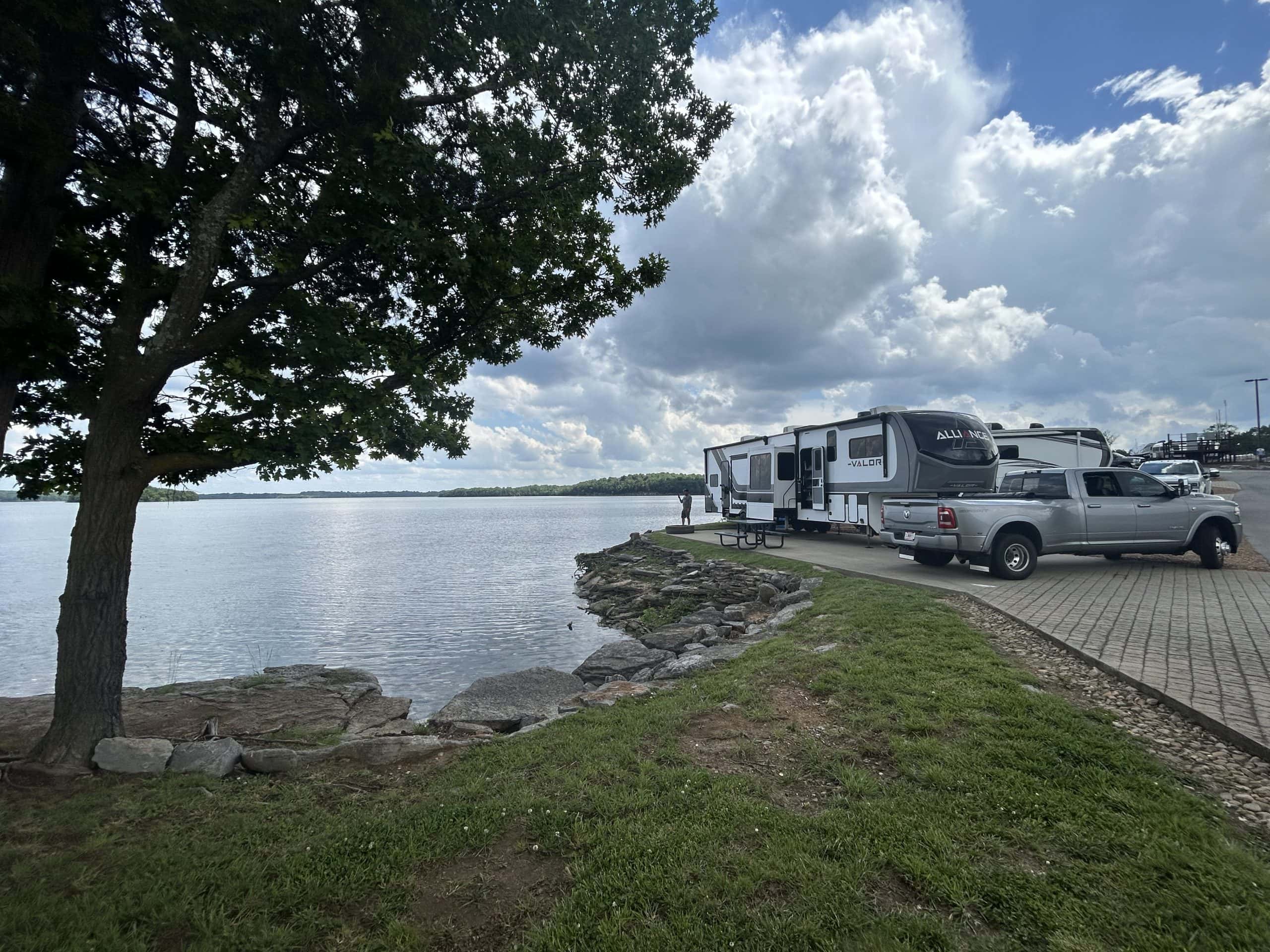Beginner’s Guide to Planning Your First RV Trip
Planning your first RV trip can feel a little overwhelming… we totally get it. Between choosing where to go, figuring out what gear you need, and wondering if you’ll accidentally take the scenic route under a 10-foot bridge 👀, it’s easy to feel in over your head.
But here’s the good news: RVing doesn’t have to be complicated!
And with the right prep (plus a few real-life lessons from folks who’ve made almost every rookie mistake in the book), your first trip can be more fun than frustrating.
We’ve been RVing for years, starting as kids and now as full-time RV travelers who’ve camped in everything from a pop-up to a 44’ fifth wheel toyhauler. We have traveled thousands of miles across the US including a recent trip from Georgia to Wyoming, and along the way, we’ve picked up a few must-know tips that’ll help you plan with confidence.

In this guide, we’ll walk you through the exact steps we use to plan every RV trip AND we will share some of our favorite tools plus a free checklist so you don’t forget anything.
Let’s hit the road (the safe way)!
This post may contain affiliate links, meaning if you click on it and make a purchases, we may receive a small commission at no cost to you. Read the full disclaimer here.
1. Where You’re Going and What Kind of Trip You Want
Before you get lost in route planners and gear lists, start with the big-picture questions:
- Where are you going?
- What kind of trip do you want this to be?
Do you have a specific destination in mind — like Grand Teton National Park, a beachside RV resort, or a friend’s driveway in another state?

Or are you more about the journey — exploring a region, checking out quirky roadside attractions, or seeing how far you can go in a weekend?
Next, think about your camping style. Are you dreaming of full hookups and resort-style amenities or is a rustic state park more your speed? Do you want to try boondocking (dry camping with no hookups) or would you rather ease in with a full-service campground?
Other questions we always ask before planning:
- How much time do we have?
- How far are we willing to drive in a day?
- Are we making stops along the way, or heading straight there?
- Who’s coming? Just us, friends, family, Coco (our furbaby)?
These questions help us decide if we are trying to get to our end destination quickly or if we want to stop and see things along the way.
The answers shape everything from route planning to packing. And if you’re unsure where to go, don’t worry. Just picking a direction is a great start.
2. Plan Your Route the Smart Way
Once you’ve nailed down your destination (or general direction), it’s time to map out your route. This is where RVing differs big time from a typical road trip.
Unlike car travel, you can’t always rely on Google Maps or Waze to get you safely from point A to point B. Low bridges, steep grades, and tight turns are real concerns especially if you’re towing a large rig or driving a Class A.
We use RV Trip Wizard (part of RV Life Pro) to plan all of our long-distance trips. It lets you plug in your rig’s height, weight, and length to avoid roads that aren’t RV-friendly.

Seriously… we love this app. After having to pass under a low-clearance bridge with our 13’4” fifth wheel, we do not wing it anymore. It was terrifying. Morgan got out to spot and Alan slowly drove under the center of the bridge. We cleared it, but barely.
RV Trip Wizard also helps us:
- Find RV-safe fuel stops
- Plan our driving days (we try to avoid pushing past 5-6 hours)
- Estimate travel costs and campground fees
If you’re traveling more than a few hours, consider breaking up the drive with an overnight stay — even better if it’s somewhere cool or relaxing. Long days behind the wheel can lead to mistakes (and grumpy travel companions).
Bottom line: plan smart, not just fast.
3. Book Your Campsites (or Know Where You Can Stay)
Once your route is mapped out, it’s time to figure out where you’ll sleep. Unlike road-tripping in a car, RVs don’t fit (and aren’t allowed overnight) in just any old parking lot (unless it’s a Cracker Barrel but even then… check first).
If you’re heading to a popular destination like a national park or a high-demand RV resort like Hilton Head National RV Resort, you’ll want to book early—but securing your spot is just the start. Learning the unwritten rules of campground life can help you make a great first impression.

That said, not every stop needs a reservation. If you’re more flexible or traveling during the shoulder season, you might be able to score same-day or last-minute spots.
We like to mix it up:
- RV resorts for amenities and longer stays
- State parks for nature and affordability
- Harvest Hosts for fun, overnight stops at wineries, farms, breweries, and museums all for the price of an annual membership (it is also nice to make a small purchase to support the host)
Use code MOTM20 to save 20% off on Harvest Hosts and/or Boondockers Welcome!
If you’re boondocking or staying somewhere unconventional, always double-check local rules and make sure your rig is truly self-contained. No one wants to be the reason Walmart bans overnight parking in your town.

We like to have a general route and plan a stop for each night (plus a backup if the route changes or takes longer than planned). It let’s us, Morgan in particular, sleep a whole lot better at night.
4. Know What to Pack and Prepare
Packing for your first RV trip is a little like moving into a tiny house on wheels. There’s a lot to remember, and forgetting something important like a surge protector or sewer hose can turn your first night into a full-on scramble.

That’s why we always use a checklist — even now, after years on the road.
You’ll want to make sure you have:
- The basics: water hoses, sewer hose, power cord and adapter, surge protector, leveling blocks
- Comfort gear: camp chairs, outdoor rug, grilling tools
- Kitchen stuff: plates, cookware, trash bags, food staples
- Pet supplies and monitoring gear (if your pup or kitty is coming too)
- Safety gear: first aid kit, fire extinguisher, tire pressure gauge
Want to make sure you don’t forget the sewer hose or surge protector?
Grab our Free RV Essentials Checklist below!
As a bonus, we’ve also rounded up our favorite tools in this post: RV Essentials for Beginners. You can also check out these helpful RV apps that make trip prep smoother and more stress-free.
You don’t need to pack your entire house, just the stuff that makes travel easier, safer, and more fun.
5. Set Realistic Expectations
You may not want to hear this, but chances are good, your first RV trip won’t be perfect… and that’s okay!
Things will go wrong. Plans will change. The water hose might leak, or you might take a wrong turn and end up facing a low-clearance bridge with sweaty palms and a panicked “Can I back up this thing?” moment.
Here’s the truth: part of RV life is learning to roll with it (pun intended).
On one of our trips, we found ourselves inches from a bridge we just barely cleared. As in, an “I’m-holding-my-breath-and-hoping” situation. We now double- and triple-check our routes using RV-specific GPS. Lesson learned.

We’ve also had tire blowouts, campground power issues, and confusing dump station encounters but none of those ruined the trip…
ok, they might have resulted in an hour or two of grumpiness but they became part of the story and, sometimes, part of the joke.
The best advice we can give?
Be prepared to adapt.
Expect a few hiccups.
Learn to shrug off the small stuff and focus on the amazing parts — the campfire views, the quiet mornings, the freedom to go where you want.
Because even the bumpy moments lead to unforgettable memories.
6. Final Prep Before You Hit the Road
With your route planned, your gear packed, and your expectations adjusted, it’s time for the final checks. This is where a little pre-trip prep can save a lot of hassle later.
Here’s what we do before every departure:
- Walk around the rig — check tires, lights, hitches, and slide-outs
- Secure everything inside — no loose items, fridge latched, drawers closed
- Double-check connections — water hose off, power unplugged, stairs up, jacks retracted
- Empty your tanks if needed and know where your next dump station is
- Check weather and road conditions for your travel day
- Confirm your first stop (and backup) just in case plans change
If you’re new, it’s totally normal to feel like you’re forgetting something. That’s why checklists are your best friend (did we mention you can grab ours? 😉).
Once you’re on the road, give yourself grace. Your first trip is a learning experience and that’s what makes it memorable.
What’s Next?
You’ve planned your first RV trip so now it’s time to make it amazing!
From what to pack to where to go, we’ve got you covered with more beginner-friendly guides:
- Already grabbed the Free RV Essentials Checklist? Awesome! You can dive deeper with our RV Essentials for Beginners guide — it’s packed with tips on what gear is worth investing in (and what you can skip).
- Need help picking your perfect first route? Here are our Best RV Travel Routes for First-Timers in the US — with a mix of scenery, fun stops, and beginner-friendly roads.
You’re on your way and the adventure is just getting started. See you down the road but hopefully NOT at the dump station!
